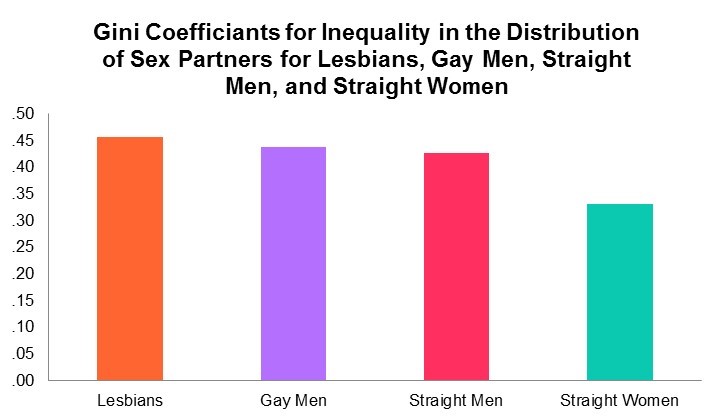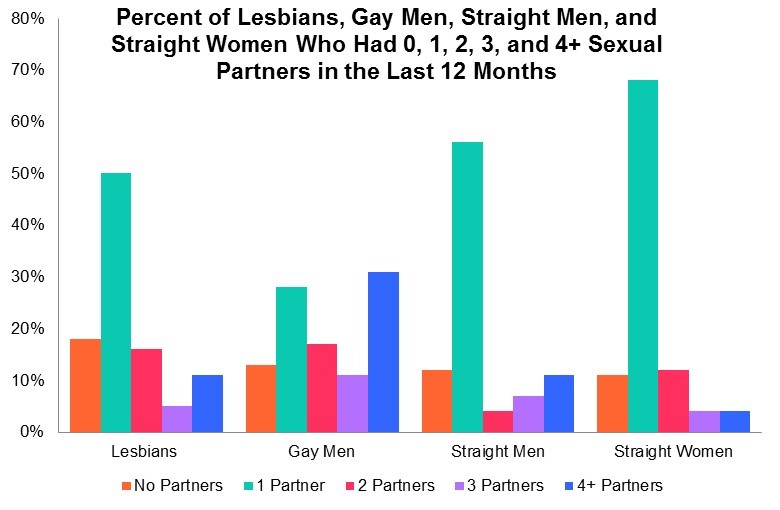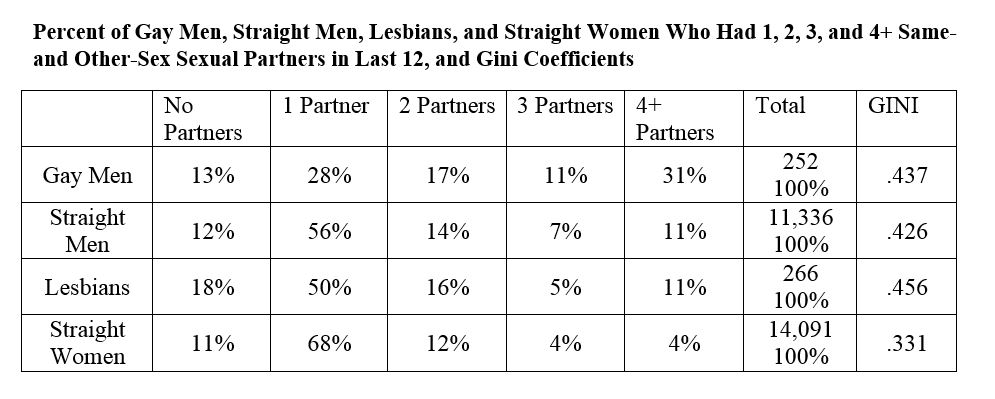an unequal distribution of partners: gays versus straights
Do some gay men have lots of partners while others have very few? Is the inequality in partnerships among gay men greater than how unequally women partners are distributed among heterosexual men? What about straight women versus lesbians?
In our last post, focused on heterosexuals, we showed that women partners are more unequally distributed among men than male partners are among women, and that partners are more unequally distributed among singles than those who are in a marital or cohabiting union. Here, using methods similar to those in our previous post, we use Gini indices to compare gay men, straight men, lesbians, and straight women in how unequally their sexual partnerships are distributed. The technical details of what we did are explained at the end of this post.
How inequality differs by gender and sexual orientation
As the graph below shows, lesbians have the most unequal distribution of partnerships, followed by gay men, then straight men, with straight women having the most equal distribution.

To understand why the groups rank in this order, we turn to the distributions of how many in each group had 0, 1, 2, 3, or 4+ partners last year, shown in the following graph. Recall from our previous post that when a group has a higher percent of its members at either extreme this raises their inequality as calculated by the Gini index.
Gay men’s partnerships with men are (slightly) more unequally distributed than straight men’s partnerships with women (.437 compared to .426) because there are more gay than straight men in the extreme category of 4+ partners last year.
But lesbians have a slightly higher Gini index than gay men (.456 compared to .437) despite having fewer in the category of 4+ than gay men; their higher Gini is mainly because more lesbians than gay men are at the other extreme, with 0 partners last year. (See our caveat about this conclusion in our section on technical details below.)
Lesbians also have more inequality than straight men despite exactly the same number in at the extreme high end, with 11% of each group having 4+ partners; lesbians’ greater inequality results from more not having any partners last year.
As we found in our previous post, female partners are distributed more unequally among straight men than male partners are among straight women mostly because, while one partner is the mode for each group, more men depart from that by having more partners.

Conclusion
Groups with a higher proportion of members having a number of partners at either extreme of the distribution (0 or 4+ partners last year) have partnerships more unequally distributed. Partnerships are most equally distributed among straight women and least so among lesbians; men are intermediate with straight men having a more equal distribution than gay men.
Technical details
As in our last post, we used data on individuals 18-35 years of age from the National Survey of Family Growth surveys collected between 2002 and 2013. Our goal was to compare gays and straights within gender, so we excluded those who said they were bisexual. We selected anyone who said they were heterosexual or gay/lesbian (the survey said homosexual, gay, or lesbian), and had ever had a partner of the sex consistent with their stated sexual orientation (i.e. we excluded heterosexuals who had never had a sexual partner of the other sex, and gays/lesbians who had never had a same-sex partner). We divide our analysis into four groups: gay men, straight men, lesbians, and straight women. We do not divide by race/ethnicity here because of the small number of gays and lesbians; however, we limited the analysis to Hispanics, nonHispanic Blacks, and nonHispanic whites to be consistent with our previous blog.
Respondents were asked their number of same- and other-sex sexual partners in the last year. Heterosexual respondents were asked this question if they reported on a previous question that they had ever had vaginal, oral, or anal sex with an other-sex sexual partner. Gay men were asked about number of same-sex partners only if they reported on a previous question that they had ever had oral or anal sex with a man. Lesbians were asked about number of same-sex partners if they reported in previous questions that they had ever had any sexual experience with a female partner. (The vast majority of lesbians said they have had oral sex with a woman, so we are relatively confident that we are picking up more than just kissing.)
For each of our four groups—gay men, straight men, lesbians, and straight women—we calculated two things: 1) what percent of people in the group had 0, 1, 2, 3, and 4 or more sexual partners in the last year, and 2) the Gini coefficient. To facilitate compact presentation, our graphs of what percent of members of a group had various numbers of partners combine those with four or more in a single category. However, the Gini coefficient uses the detailed data on exactly how many partners each person reported except that it is truncated at 6+, so anyone having more than 6 partners last year was scored as 6. NSFG did this truncation for gay men only. Since this truncation reduces the Gini for this group, we assigned anyone in the other three groups who had over 6 partners a 6 as well for consistency. Thus a caveat to our conclusions is that, if, within the group of those with more than 4 partners, more gay men than lesbians have had very large number, then we may be understating the Gini for gay men relative to the other groups. In particular, our conclusion that lesbians have a higher Gini than gay men may be suspect.
To calculate the Gini coefficient for each group we treated the number of partners of a given sex people in the group had in the last year just like those studying income inequality treat the number of dollars of income a family had in the last year. The formula and an explanation of the Gini coefficient applied to income can be found at this link.
The smaller the Gini coefficient, the more equal the distribution of partners is. The Gini coefficient is 0 if the resource is absolutely equally distributed. In the case of income, this would mean that every household had exactly the same income. In the case of sexual partners, it would mean that all members of the group had the same number of partners in the last year. At the other end of the scale, a Gini coefficient of 1 means the maximum inequality. The Gini tends to be higher for groups where there is a higher percent of people departing from the modal category in either direction, particularly at an extreme.


Comments 9
Jacob Blaustein
February 29, 2020Do you explain why this is?
jackmskst
June 6, 2020Thank you so much for this. I was into this is https://tracktrace.one/usps/ sue and tired to tinker around to check if its possible but couldnt get it done. Now that i have seen the way you did it, thanks guys
with
regards
makcst
June 6, 2020Thanks for sharing.I found a lot of inter
kodi.software esting information here. A really good post, very thankful and hopeful that you will write many more posts like this one.
Liam
July 25, 2020great article!
Elisabeth
August 25, 2020I don't think it's something to worry about. Now there are so many sick and dependent people walking among you, that's what should frighten you. And it is good when they themselves understand their addiction and seek help in a clinic https://drvorobjev.com/, but what if not everyone does it?
suka min
September 23, 2020In the context of the epidemic that the world is facing you and your family, let's protect your health against corona virus. shell shockers
good
February 17, 2021This blog is really great. The information here will surely be of some help to me. Thanks!.
Francois
August 8, 2022You cannot really compute the Gini coefficient because you do not have data beyond 4 partners. 30 percent of gay men report having 4 partners or more, bit we do not know if they had 4 or 40...
Peter (MD)
April 6, 2024Self reporting surveys are bound to be grossly inaccurate, based on our clinical experience.
We've often had gay men in our clinics who initially deny being gay, then on closer questioning have scores of partners a year, after an STI is diagnosed and more careful scrutiny required.